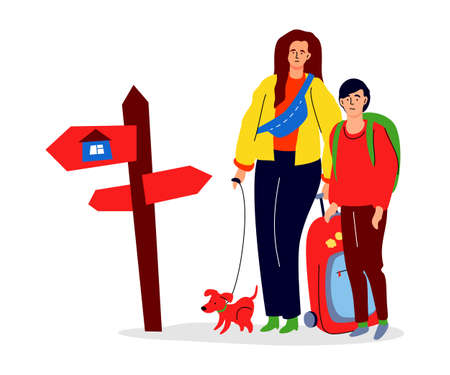1. Preparing Your Pet for Travel
Before hitting the road or taking to the skies with your furry companion, its crucial to ensure they are fully prepared for the journey ahead. A well-prepared pet will have a much smoother and stress-free travel experience. Here are some essential steps to get your pet ready for travel.
Schedule a Vet Visit
One of the first things you should do before traveling with your pet is to visit your veterinarian. A check-up will help confirm that your pet is healthy enough for travel. Your vet may also provide recommendations based on your destination, such as additional vaccinations or preventive medications.
Key Health Checks Before Traveling:
| Health Check | Description |
|---|---|
| General Health Examination | Ensure your pet is in good health and fit for travel. |
| Vaccinations | Update required vaccinations based on destination requirements. |
| Pest Prevention | Check for fleas, ticks, and other parasites; consider preventive treatments. |
| Anxiety Management | If your pet gets anxious while traveling, discuss calming options with your vet. |
Ensure Vaccinations Are Up-to-Date
Certain destinations may require specific vaccinations, so make sure your pet’s shots are current. Common vaccines include rabies, distemper, and bordetella. If youre traveling internationally, research the countrys vaccination requirements well in advance.
Prepare Necessary Travel Documents
If youre flying or crossing borders, you may need official paperwork for your pet. Airlines and foreign countries often require health certificates issued by a licensed vet within a specific timeframe before travel.
Common Travel Documents Needed:
- Health Certificate: Proof from a vet stating your pet is healthy for travel.
- Vaccination Records: Documentation of required vaccines, including rabies shots.
- ID Tags & Microchip Information: Ensure your pet has proper identification in case they get lost.
- Airline-Specific Forms: Some airlines require additional paperwork, so check their policies in advance.
Create a Comfortable Travel Routine
A few weeks before departure, start preparing your pet for the journey by familiarizing them with their travel carrier or crate. Take short trips to help them adjust to being in a confined space during transit.
Tips for Crate Training:
- Select the Right Size: Your pet should be able to stand up and turn around comfortably inside their crate.
- Add Familiar Items: Place a favorite blanket or toy inside to create a sense of comfort and security.
- Praise & Rewards: Encourage positive associations by giving treats when they enter the crate voluntarily.
- TSA-Approved Crates: If flying, ensure the carrier meets airline regulations for cabin or cargo transport.
A little preparation goes a long way in ensuring both you and your pet have an enjoyable and stress-free trip. By following these steps, youll set the foundation for a smooth journey ahead!
2. Choosing the Right Mode of Transportation
When planning a trip with your pet, choosing the right mode of transportation is crucial for their comfort and safety. Each travel method has its own advantages and challenges, so its important to consider what works best for both you and your furry companion.
Pros and Cons of Different Travel Methods
| Mode of Transportation | Pros | Cons |
|---|---|---|
| Car Travel | – Flexible schedule – Can stop for breaks – Less stressful for pets used to car rides |
– Long trips can be tiring – Motion sickness in some pets – Requires frequent stops for bathroom breaks |
| Plane Travel | – Fastest option for long distances – Some airlines allow small pets in the cabin |
– Expensive – Can be stressful for pets, especially in cargo – Strict airline regulations and paperwork requirements |
| Train Travel | – More spacious than planes – Some pet-friendly train services available |
– Limited routes allow pets – May require advance booking and fees |
| Bus & Other Public Transport | – Budget-friendly – Some pet-friendly options exist |
– Many buses don’t allow pets – Crowded spaces can be stressful for animals |
Tips for Ensuring Your Pets Comfort and Safety
If Traveling by Car:
- Buckle Up: Use a pet seatbelt or secured carrier to keep your pet safe.
- Avoid Leaving Pets Alone: Never leave your pet unattended in a parked car, especially in hot or cold weather.
- Create a Comfortable Space: Bring their favorite blanket or toy to make them feel at home.
- Tire Them Out: Exercise your pet before long drives to help them relax.
- Pit Stops: Plan regular bathroom and exercise breaks every 2-3 hours.
If Traveling by Plane:
- Check Airline Policies: Every airline has different rules regarding pet travel, so research in advance.
- Select the Right Carrier: Choose an airline-approved carrier that allows your pet to stand, turn around, and lie down comfortably.
- Avoid Cargo If Possible: If allowed, book a flight where your pet can travel in the cabin with you.
- ID and Documentation: Ensure your pet has proper identification tags and any required health certificates.
- No-Feed Rule Before Flight: Avoid feeding your pet right before flying to prevent motion sickness.
If Traveling by Train or Bus:
- Kennel Training: Many train and bus companies require pets to stay in carriers, so get them comfortable beforehand.
- Noisy Environment Preparation: Trains and buses can be loud; playing recorded sounds at home beforehand may help desensitize your pet.
- Avoid Peak Hours: Traveling during less crowded times will reduce stress for both you and your pet.
- Packing Essentials: Bring water, food, waste bags, and any necessary travel documents.
The best travel option depends on your destination, budget, and most importantly, your pet’s comfort level. Always plan ahead, ensure safety precautions are met, and create a stress-free experience for both you and your furry friend!

3. Packing Essentials for Your Pet
Making sure you have everything your pet needs is key to a smooth and stress-free journey. Whether youre traveling by car, plane, or train, packing the right essentials will help keep your furry friend comfortable and happy. Here’s a checklist of must-have items:
Essential Items for Your Pets Travel Bag
| Category | Items |
|---|---|
| Food & Water | Pet food, portable food and water bowls, bottled water, treats |
| Health & Safety | Medications, vaccination records, first aid kit, flea/tick prevention |
| Comfort & Entertainment | Favorite toys, blanket or bed, chew toys, calming spray (if needed) |
| Travel Accessories | Leash, harness, waste bags, ID tags, carrier or crate |
| Cleaning Supplies | Towels, pet wipes, brush, lint roller |
Packing Tips for a Hassle-Free Trip
Keep Food and Water Accessible
Your pet’s food and water should be easy to reach during travel. If youre driving, keep a spill-proof bowl handy. For flights, check airline regulations on carrying pet food.
Create a Comfortable Space
A familiar blanket or favorite toy can provide comfort and reduce anxiety. If using a crate or carrier, line it with soft bedding.
Cater to Your Pet’s Needs
If your pet takes medication, pack extra doses in case of delays. For pets prone to anxiety, consider natural calming treats or sprays.
ID and Documentation Are a Must
An updated ID tag with your contact information is crucial in case your pet gets lost. If traveling internationally or by air, carry vaccination records and necessary paperwork.
Packing smart ensures that both you and your pet enjoy a smooth and stress-free adventure!
4. Finding Pet-Friendly Accommodations
Choosing the right place to stay is essential when traveling with pets. Not all hotels, Airbnbs, or camping sites are pet-friendly, so doing a little research beforehand can make your trip much smoother. Here’s how you can find the best accommodations for you and your furry friend.
How to Choose Pet-Friendly Hotels
Many hotels claim to be pet-friendly, but policies vary widely. Some charge extra fees, while others have strict size or breed restrictions. Here are some key factors to consider:
| Factor | What to Look For |
|---|---|
| Pet Fees | Check if there are additional charges per night or per pet. |
| Pet Policy | Some hotels allow only small dogs, while others welcome all pets. |
| Amenities | Look for pet-friendly perks like designated potty areas, pet beds, or treats. |
| Nearby Green Spaces | Parks or walking trails nearby make potty breaks easier. |
| Noisy Environment | Avoid places near busy streets that may stress your pet. |
Finding a Pet-Friendly Airbnb
If you prefer a more home-like stay, Airbnb can be a great option. However, not all hosts allow pets. Here’s how to find the right place:
- Use filters: When searching, select “Pet-Friendly” under amenities.
- Read house rules: Some listings may allow pets but have restrictions on certain areas of the house.
- Message the host: If in doubt, ask about their pet policy before booking.
- Avoid shared spaces: A private home is usually more comfortable for both you and your pet.
- Check for outdoor space: A fenced yard can be a huge plus for dogs.
Selecting a Pet-Friendly Campsite
Camping with pets can be an amazing experience, but not all campsites allow animals. Consider these factors when choosing a spot:
- Campsite Rules: Confirm that pets are allowed and check any leash regulations.
- Paw-Friendly Terrain: Avoid rocky or extremely hot surfaces that could hurt paws.
- Shelter & Shade: Ensure there are shaded areas where your pet can rest comfortably.
- Noisy Surroundings: Choose a quieter location away from busy roads or loud groups.
- Nuisance Wildlife: Be aware of local wildlife that could pose a risk to your pet.
Making Your Stay Enjoyable for You and Your Pet
No matter where you stay, keeping your pet happy and comfortable is key. Here are some tips to ensure a stress-free experience:
- Create a familiar space: Bring your pet’s bed, blanket, or favorite toy to make them feel at home.
- Keeps meals consistent: Stick to their regular feeding schedule and bring their usual food.
- Avoid leaving them alone: Many pets get anxious in new environments, so try not to leave them unattended for long periods.
- Puppy-proof the room: Check for hazards like exposed wires or open trash cans that curious pets might get into.
- Clean up after your pet: Always follow house rules and pick up after them to ensure future travelers can enjoy the same accommodations.
Selecting the right accommodation can make all the difference in ensuring a smooth and enjoyable trip with your furry companion. With a little planning, you and your pet can have an amazing adventure together!
5. Handling Travel Stress and Emergencies
Traveling with your pet can be an exciting adventure, but it also comes with challenges, including stress and unexpected emergencies. Knowing how to keep your pet calm and handle potential issues on the road will ensure a smoother journey for both of you.
Ways to Keep Your Pet Calm During Travel
Pets can experience anxiety when traveling, especially if they are not used to being in a car or on a plane. Here are some effective ways to help them stay relaxed:
- Bring Familiar Items: A favorite blanket, toy, or bed can provide comfort and make your pet feel secure.
- Use Calming Treats: Some pets respond well to calming treats or chews that contain natural ingredients like chamomile or CBD.
- Create a Comfortable Space: Ensure your pet’s carrier or seat area is cozy with enough ventilation and room to move.
- Play Soothing Music: Soft classical music or specially designed pet relaxation playlists can help reduce stress.
- Avoid Feeding Right Before Travel: A light meal a few hours before departure can prevent motion sickness.
- Keep the Temperature Comfortable: Avoid extreme heat or cold by adjusting the car’s climate control.
How to Address Anxiety During Travel
If your pet shows signs of anxiety—such as excessive panting, whining, or pacing—you may need to take additional steps to calm them down.
| Anxiety Sign | What You Can Do |
|---|---|
| Panting or Whining | Speak in a calm voice and offer a favorite toy or treat. |
| Pacing in the Car | Use a secure carrier or pet seatbelt to provide stability. |
| Trembling or Hiding | Cover their crate partially with a blanket for a den-like feel. |
| Barking Excessively | Try distraction techniques such as playing soft music or giving them a chew toy. |
What to Do in Case of a Medical Emergency on the Road
No one wants to think about medical emergencies while traveling, but being prepared can make all the difference. Follow these steps if your pet needs urgent care:
1. Identify the Symptoms
If your pet is vomiting excessively, has difficulty breathing, collapses, or suffers an injury, seek immediate help.
2. Find the Nearest Vet Clinic
Use apps like Google Maps or AAHA’s vet locator to locate an emergency vet nearby.
3. Administer Basic First Aid
- If bleeding: Apply gentle pressure with a clean cloth.
- If choking: Carefully remove any visible obstruction (if safe).
- If overheating: Move them to a cool area and offer water in small amounts.
- If ingesting something toxic: Call the ASPCA Poison Control Hotline.
4. Keep Emergency Contacts Handy
Create a list of important contacts, including your regular vet and nearby emergency clinics in your travel destination.
5. Carry an Emergency Kit
A well-stocked pet first aid kit can be lifesaving. Here are essential items to include:
| Item | Purpose |
|---|---|
| Gauze & Bandages | Covers wounds and controls bleeding. |
| Tweezers & Scissors | Removes splinters and trims bandages. |
| A Digital Thermometer | Makes sure their temperature is normal. |
| A Bottle of Fresh Water & Bowl | Keeps them hydrated during emergencies. |
| An Extra Leash & Collar with ID Tag | Avoids losing your pet if they get scared and run off. |
The key to managing travel stress and emergencies is preparation. By keeping your pet comfortable, recognizing signs of distress, and knowing what actions to take in case of an emergency, you can enjoy a worry-free trip together!


